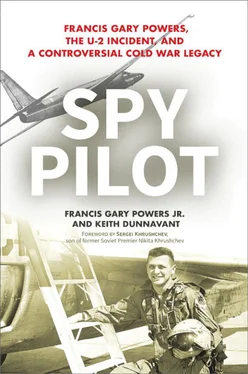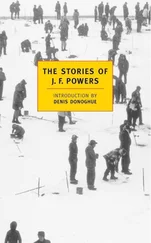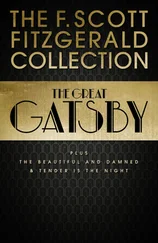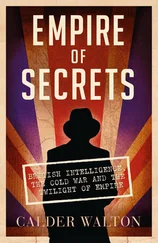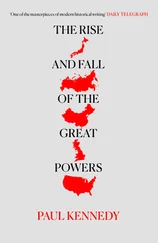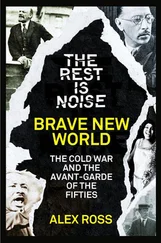Since the early days of the program, U-2 pilots had been given the option to carry along a specially designed poison pin hidden inside a silver dollar. Once dislodged from the coin, the pin could be used to prick the skin, causing death by asphyxiation. Like many of his contemporaries, Powers routinely declined to carry the suicide device. This time, however, facing the longest flight so far over the Soviet Union, Frank made a snap decision and slipped the dollar into the pocket of his outer flight suit.
After going through his two-hour preflight breathing ritual, isolation in a pure oxygen environment to prepare for the long flight and prevent the debilitating ailment known as “the bends,” Powers, wearing his pressure suit and helmet, carefully stepped up the ladder with the assistance of a colleague and into the plane, locking into his seat around 5:20 a.m., with departure scheduled for 6. The sun had been up for nearly an hour, and it was already very hot. To try to give his friend a little shade, one of the other pilots took off his shirt and held it over the cockpit.
Because of the unusual situation, President Eisenhower needed to personally approve the flight. As six o’clock came and went without word from the White House, and the morning sun turned the open cockpit into an oven, sweat soaked through Frank’s long johns and rolled down his face.
The warning signs were flashing.
In arguing for what became the April 9, 1960, flight, code named Square Deal, to originate from Pakistan, Air Force Colonel William Burke expressed the opinion that penetrating the USSR from this area presented “a reasonable chance of escaping detection by the Soviet air defense system.” 1On this, Burke, the acting director of the Development Projects Division, was proven wrong. Soon after U-2 pilot Bob Ericson crossed into Soviet territory, he was tracked by Soviet radar, ringing alarm bells throughout the defense establishment.
Despite seeing contrails of MiGs beneath him, Ericson successfully completed his mission and secured evidence of Soviet ICBM deployment near Plesetsk, about 700 miles north of Moscow. The gamble paid off. Khrushchev was especially angered by the timing of the flight, since preparations for the summit were already underway. He watched with frustration, believing his military bungled several opportunities to shoot the U-2 out of the sky. 2He said nothing, which emboldened the White House. “This was virtually inviting us to repeat the sortie,” recalled George Kistiakowsky, Eisenhower’s science advisor. 3
For nearly four years, the CIA had prowled the skies above the USSR with impunity.
But the steady improvement in Soviet defenses was reaching critical mass.
“By the beginning of 1960,” Bissell conceded many years later, “we were all growing concerned about the U-2’s future and there was considerable discussion of how long it might be before the Soviets developed the capability to shoot one down.” 4
Especially troubling was the technical progress embodied in the SA-2 missile, rapidly being deployed across the Soviet Union. In a confidential assessment dated March 14, 1960, Burke advised Bissell, “The SA-2 Guideline has a high probability of successful intercept at 70,000 feet providing that detection is made in sufficient time to alert the site.” 5This was a key proviso. While the SA-2 had apparently achieved the ability to reach the U-2’s maximum altitude, its effective firing zone and maneuverability remained unknown, turning the possibility of a direct hit into a complicated math problem. The CIA’s analysts remained skeptical of the Soviet guidance systems, which gave the pilots a measure of reassurance.
“Because of the speed of the missile and the extremely thin atmosphere, it was almost impossible to make a connection,” Powers said. “This did not eliminate the possibility of a lucky hit.” 6
In the context of a clear linkage between early warning and missile danger, a memorandum written by Burke on April 26 reflected the elevated level of risk: “Experience gained as a result of Operation Square Deal indicates that penetration without detection from the Pakistan/Afghanistan area may not be as easy in the future as heretofore.” 7
The policy makers in Washington knew they were playing a very dangerous game by sending Francis Gary Powers into this vortex.
Like the other pilots, Powers began to worry about the growing potential of Soviets defenses. Discussing the situation many years later, he said, “Four years is a long time…. They know you’ve been flying over their country for four years…. I figured [if the roles were reversed] we in this country would be working night and day to develop something to try to stop [such incursions]. It’s getting to about the point where you can expect things to happen.” 8
One of the primary reasons the agency pushed for an additional flight before the deadline was to get another look at the Plesetsk facility, to judge the Soviet ICBM progress. Aware that the angle of the sun in the northern latitudes could distort the U-2 pictures starting in midsummer, Bissell feared, “If a flight could not be conducted [between April and July], the opportunity would be lost for an entire year.” 9
Because telephone communications between Washington and Peshawar could not be secured, the White House arranged to transmit the president’s order through Morse code early on the morning of Sunday, May 1. While Powers sweated in his pressure suit, believing more strongly with each passing minute that the flight would be canceled, Colonel Shelton waited impatiently with an aide inside a radio van on the taxiway. Due to technical problems likely related to atmospherics, they were unable to retrieve the signal on the assigned frequency.
Eventually tuning to another channel, they picked up a message, slightly truncated from what they were expecting: HBJGO. Convinced that this was the signal they had been waiting for, even though several letters were missing, Shelton stepped out of the van and ran over to the U-2 to deliver the news: The White House had given Powers clearance to fly Mission 4154, code named Grand Slam, over the Soviet Union. 10
It was around 6:20 when a member of the crew pulled the ladder away and slammed the canopy shut. The pilot then locked it from the inside. As Powers taxied on to the runway and carefully guided the U-2C, model 360, into the air, the J75/P13 engine roared with a distinctive whine. He never lost the thrill of hearing the familiar sound.
Quickly climbing toward his assigned altitude and switching into autopilot for his twenty-eighth reconnaissance mission, he headed toward Afghanistan and initiated a single click on the radio. Seconds later, he heard a single click as confirmation. This was his signal to proceed as scheduled, in radio silence.
Determined to pack as much surveillance as possible into one flight, Powers was scheduled to cross over the Hindu Kush range of the Himalayas and into the southern USSR, passing over a 2,900-mile swath of Soviet territory, from Dushambe and the Aral Sea, to the rocket center of Tyuratam, and on to Sverdlovsk, where he would head northwest, reaching the key target of Plesetsk before turning even farther northwest, toward the Barents Sea port of Murmansk. Exiting to the north, he was to land in Bodo, Norway, where a recovery team was waiting to transport the U-2 and secure the pilot. In the case of an emergency, such as running low on fuel, he was authorized to take a shortcut into the neutral nations of Sweden or Finland, which would be sure to cause complications for Washington. But as Shelton remarked, “Anyplace is preferable to going down in the Soviet Union.” 11
The Soviets were especially dangerous if they knew the U-2 was coming. According to an official protest subsequently lodged with the US government by the foreign minister of Afghanistan, for violating their sovereign airspace on the way north, the Soviets provided an early warning of the spy plane’s incursion. 12
Читать дальше
